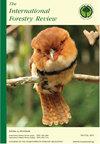Community-based forest monitoring for REDD+ MRV in the Ansaka Conservation Area, Ghana
IF 0.9
4区 农林科学
Q2 FORESTRY
引用次数: 1
Abstract
A community-based monitoring (CBM) approach creates a working relationship between scientists, resource managers and local communities to address natural resource problems. This study analyses CBM data from Ankasa Conservation Area (ACA), Ghana, and assesses how such a CBM model fits into the national Measurement, Reporting and Verification (MRV) system for REDD+. Satellite imagery was used to generate land cover change maps for the different land use categories in ACA. A checklist of deforestation and forest degradation-related activities was designed with inputs from study communities. Nominated community members were trained to collect the data. The land use categories identified in the study area include closed forest, open forest, farmland, bare area, and grassland. The remote sensing data revealed significant land use and land cover changes in the periphery of ACA between 1990 and 2014. Closed forest and open forest areas recorded 28.6% and 35.0% reductions respectively. Data from the CBM showed that cash crop farms and plantations (rubber and coconut) account for the sharp increase (479.9%) in farmlands. The predominant sighting of rodents by community monitors reinforced the deforestation and forest degradation findings in the ACA periphery. A participatory MRV system is essential for the success of REDD+ interventions. With little training, local people can collect forest condition data that are of interest to REDD+ implementation and international policies related to climate change.加纳安萨卡保护区REDD+ MRV社区森林监测
基于社区的监测(CBM)方法在科学家、资源管理者和当地社区之间建立了一种工作关系,以解决自然资源问题。本研究分析了来自加纳Ankasa保护区(ACA)的CBM数据,并评估了这种CBM模型如何适应REDD+的国家测量、报告和验证(MRV)系统。利用卫星图像生成了不同土地利用类型的土地覆盖变化图。根据研究社区的投入,设计了一份与毁林和森林退化有关的活动清单。指定的社区成员接受了收集数据的培训。研究区土地利用类型包括封闭森林、开放森林、农田、裸地和草地。遥感数据显示,1990 - 2014年,中国大陆外围地区土地利用和土地覆盖发生了显著变化。封闭林区和开放林区分别减少28.6%和35.0%。CBM的数据显示,经济作物农场和种植园(橡胶和椰子)占农田面积急剧增加(479.9%)。社区监测人员对啮齿动物的主要发现强化了在ACA外围地区森林砍伐和森林退化的发现。参与性MRV系统对于REDD+干预措施的成功至关重要。当地居民只需经过很少的培训,就能收集到与REDD+实施和气候变化相关的国际政策相关的森林状况数据。
本文章由计算机程序翻译,如有差异,请以英文原文为准。
求助全文
约1分钟内获得全文
求助全文
来源期刊

International Forestry Review
农林科学-林学
CiteScore
2.50
自引率
6.20%
发文量
29
审稿时长
>36 weeks
期刊介绍:
The International Forestry Review is a peer-reviewed scholarly journal that publishes original research and review papers on forest policy and science, with an emphasis on issues of transnational significance. It is published four times per year, in March, June, September and December. Special Issues are a regular feature and attract a wide audience. Click here for subscription details.
 求助内容:
求助内容: 应助结果提醒方式:
应助结果提醒方式:


